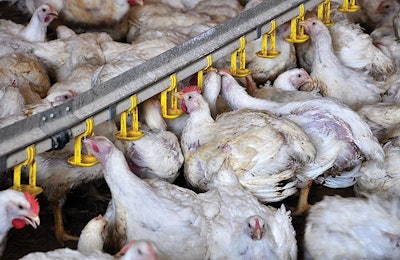
Although there are various ways to raise broilers, ranging from conventional production to no antibiotics ever (NAE), Dr. Don Ritter, director of technical marketing, Mountaire Farms, advocated that the industry take a balanced approach to antibiotics usage.
“Antibiotics are a very important shared resource and we’re not going to get new ones any time soon, so all users of antibiotics need to do their part to ensure that they work not only today but also for future generations,” Ritter said, speaking on October 9 at the Delmarva Poultry Industry’s 2018 National Meeting on Poultry Health, Processing and Live Production.
The Food and Drug Administration (FDA) has approved the uses of antibiotics in food animals for disease treatment, disease control, disease prevention and production purposes, giving poultry producers options but also causing more confusion. With conventional production, any FDA-approved product can be used according to the product’s label specifications. Pros of this type of system, Ritter said, are that it creates a predictable supply chain for customers and maintains good poultry health outcomes. However, conventional production uses the most human medically important drugs and does not meet the customer specifications for a growing list of retailers.
A more moderate approach taken by some producers is Certified Responsible Antibiotic Use (CRAU), which allows the use of medically important drugs only to treat sick animals but not for prevention. Ritter said the positives of this system-based program mean it does not require diversion of treated flocks, still provides a consistent supply chain and high poultry health outcomes, but uses less medically important antibiotics than conventional production. However, the absence of a CRAU retail label is a negative and the program’s complexity makes messaging difficult.

Dr. Don Ritter | Photo by Alyssa Conway
Similar to CRAU but more restrictive is no antibiotics important in human medicine (NAIHM). Under this program, medically important human drugs are not allowed and no antibiotics are given in the hatchery. But Ritter said this type of program puts poultry welfare at risk with pressure not to treat sick flocks and creates an unpredictable supply chain for customers.
The most extreme approach Ritter outlined is producing under a no antibiotics ever (NAE) policy, which does not allow antibiotics in hatchery, feed or water. This is the most common antibiotic use retail label in poultry and provides clear messaging to customers. Yet, because producers are not allowed to use antibiotics to treat sick flocks, it creates an unpredictable supply chain for customers because sick flocks need to be diverted and also puts poultry welfare at risk.
In spite of these options, Ritter referenced Nielsen retail and grocery sales data from July 2018 showing 89 percent of chicken sold is still no-claim, conventional chicken, while NAE only makes up 5 percent of chicken sold.
Unintended consequences of NAE production
Ritter emphasized that providing options in the marketplace is good, but that has also brought about both production and marketing challenges to the industry. In terms of production, birds that get sick still need to be treated under an NAE program, meaning that there has to be an outlet to divert these birds and sell the meat.
Additionally, so many types of production and terms related to antibiotic usage confusing marketing claims for consumers. Ritter said that 35 to 75 percent of consumers believe their meat contains harmful levels of antibiotics that they are going to eat when they see a package labeled “no antibiotics ever” next to one that is not labeled.
“Choice is good, but I think judgment is bad. Judgement has entered this space and I think we need to avoid that,” he said. “A better goal is to provide transparent information to customers and consumers so that they can make their own decision.”
An alternative approach: One Health Certified
Ritter outlined a new standard being developed for poultry production called One Health Certified.
The goal of developing this program is to create an animal production standard that has meaning and value to customers, applies across commodity groups and is also audited by USDA.
The standard has five core principles:
- A biosecurity program to keep disease out
- An animal health plan including mandatory treatment protocols for sick animals
- Responsible antibiotic stewardship
- Third-party audited animal welfare program
- Environmental measurements
Since it is a system-based program, Ritter said there would be no need to divert product, creating still a consistent product supply. According to Ritter, the program has been pitched to 29 retailers across the country, all with positive feedback. He also explained that the One Health Certified concept will be a living standard that strives for continuous improvement. He said the industry is hoping to roll out One Health Turkey and One Health Chicken by the end of 2018.















